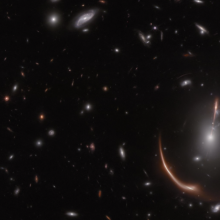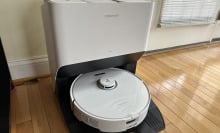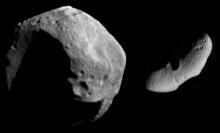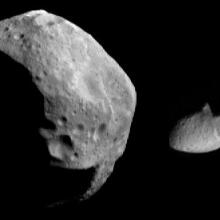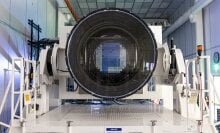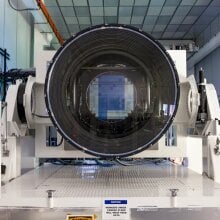A new dawn of peering into the deep, deep, deep cosmos has begun.
Scientists have released the first highly-anticipated, full-color, scientific images captured by the James Webb Space Telescope, the most powerful such instrument ever built. The colossal telescope orbits around 1 million miles from Earth, and is positioned to peer at some of the earliest galaxies and stars ever born. Looking at these objects means looking back in time billions of years, because it takes that long for this ancient light to reach us (or more precisely, reach the $10 billion Webb telescope).
This first batch of unprecedented images includes views of some of the most distant galaxies, a giant star nursery, and colossal cosmic clouds. It also gives unparalleled insight into a giant planet beyond our solar system. (The memes aren't bad, either.)
"Today the Webb mission is open for business," NASA astronomer Michelle Thaller said at the image unveiling Tuesday morning. "And this is only the beginning. The best is yet to come."
Tweet may have been deleted
The Webb telescope is the successor to the legendary Hubble Space Telescope, which has captured unprecedented stellar views for over three decades. But the Webb telescope, with a gold-tinted mirror over two-and-a-half times larger than Hubble's, has the ability to see much fainter objects, and will peer through previously impenetrable clouds of thick cosmic dust.
Behold five of the most anticipated space images ever.
SMACS 0723
Webb spied an "extremely distant" population of galaxies in this image. Galaxies in the foreground distort light and help magnify these faraway objects.
The light from those galaxies has been traveling for billions of years, NASA administrator Bill Nelson explained. Specifically, you're looking at the galaxy cluster SMACS 0723 as it appeared some 4.6 billion years ago. Behind it, however, are more ancient galaxies in just one small patch of the universe.
"This first image from NASA’s James Webb Space Telescope is the deepest and sharpest infrared image of the distant universe to date. Known as Webb’s First Deep Field, this image of galaxy cluster SMACS 0723 is overflowing with detail," NASA explained in a statement. "Thousands of galaxies – including the faintest objects ever observed in the infrared – have appeared in Webb’s view for the first time. This slice of the vast universe covers a patch of sky approximately the size of a grain of sand held at arm’s length by someone on the ground."

Exoplanet spectrum from WASP-96 b
Some of the Webb telescope's most stunning observations won't come from any pretty images. Using instruments called spectrometers, Webb can sleuth out what the atmospheres of distant, alien worlds are composed of. (There are perhaps a trillion or more exoplanets in our Milky Way galaxy alone.) Some planets, for example, might contain water, methane, and carbon dioxide, which could potentially mean they're habitable worlds.
Webb's first spectrum of the gases on an exoplanet comes from WASP-96 b, known as a "hot Jupiter." It's a high-temperature gas giant that zooms around its star at tremendous speeds, taking just 3.4 days for a single orbit.
"NASA’s James Webb Space Telescope has captured the distinct signature of water, along with evidence for clouds and haze, in the atmosphere surrounding a hot, puffy gas giant planet orbiting a distant Sun-like star," NASA explained. "The observation, which reveals the presence of specific gas molecules based on tiny decreases in the brightness of precise colors of light, is the most detailed of its kind to date, demonstrating Webb’s unprecedented ability to analyze atmospheres hundreds of light-years away."
Webb's scientists plan to also point the powerful telescope at smaller, rocky, perhaps Earth-like worlds. There could be well over a trillion exoplanets in our galaxy alone. But we know vanishingly little about them.
"We've only been able to barely scratch the surface," Néstor Espinoza, an exoplanet researcher at the Space Telescope Science Institute, told Mashable last year.

Tweet may have been deleted
The Southern Ring Nebula
The Southern Ring Nebula is a type of object called a "planetary nebula." These are vivid shells of gas and dust expelled into space by a dying star. This well-known planetary nebula is some 2,000 light-years from us.
"Some stars save the best for last," NASA wrote. "The dimmer star at the center of this scene has been sending out rings of gas and dust for thousands of years in all directions, and NASA’s James Webb Space Telescope has revealed for the first time that this star is cloaked in dust."

Stephan’s Quintet
Stephan's quintet is a well-know group of galaxies some 290 million light-years away. Four of them are relatively close to one another, "locked in a cosmic dance of repeated close encounters," said NASA.
"With its powerful, infrared vision and extremely high spatial resolution, Webb shows never-before-seen details in this galaxy group," NASA explained. "Sparkling clusters of millions of young stars and starburst regions of fresh star birth grace the image. Sweeping tails of gas, dust and stars are being pulled from several of the galaxies due to gravitational interactions."

The Carina Nebula
Nebulae are some of the most dazzling regions of space. They're giant clouds of dust and gas, like those formed after a giant star's explosion. They're fertile grounds for new stars to form. Webb captured a view of the colossal Carina Nebula, located some 7,600 light-years away, a place where large stars have already formed.

"This landscape of 'mountains' and 'valleys' speckled with glittering stars is actually the edge of a nearby, young, star-forming region called NGC 3324 in the Carina Nebula," wrote NASA. "Captured in infrared light by NASA’s new James Webb Space Telescope, this image reveals for the first time previously invisible areas of star birth." The tallest 'peaks' you see here are some seven light-years high, the space agency added.
The deep space observatory
The Webb telescope — a collaboration between NASA, the European Space Agency, and the Canadian Space Agency — is designed to make unprecedented discoveries. "With this telescope, it's really hard not to break records," Thomas Zurbuchen, an astrophysicist and NASA’s associate administrator for the agency's Science Mission Directorate, recently said at a press conference.

Here's how Webb will achieve unparalleled things:
Giant mirror: Webb's mirror, which captures light, is over 21 feet across. That's over two and a half times larger than the Hubble Space Telescope's mirror. Capturing more light allows Webb to see more distant, ancient objects. The telescope will peer at stars and galaxies that formed over 13 billion years ago, just a few hundred million years after the Big Bang.
"We're going to see the very first stars and galaxies that ever formed," Jean Creighton, an astronomer and the director of the Manfred Olson Planetarium at the University of Wisconsin–Milwaukee, told Mashable last year.
Infrared view: Unlike Hubble, which largely views light that's visible to us, Webb is primarily an infrared telescope, meaning it views light in the infrared spectrum. This allows us to see far more of the universe. Infrared has longer wavelengths than visible light, so the light waves more efficiently slip through cosmic clouds; the light doesn't as often collide with and get scattered by these densely-packed particles. Ultimately, Webb's infrared eyesight can penetrate places Hubble can't.
"It lifts the veil," said Creighton.
Peering into distant exoplanets: The Webb telescope carries specialized equipment, called spectrometers, that will revolutionize our understanding of these far-off worlds. The instruments can decipher what molecules (such as water, carbon dioxide, and methane) exist in the atmospheres of distant exoplanets — be it gas giants or smaller rocky worlds. Webb will look at exoplanets in the Milky Way galaxy. Who knows what we'll find.
"We might learn things we never thought about," Mercedes López-Morales, an exoplanet researcher and astrophysicist at the Center for Astrophysics-Harvard & Smithsonian, told Mashable in 2021.
Topics NASA



